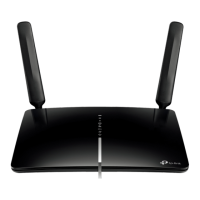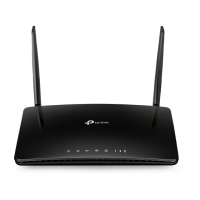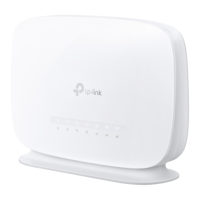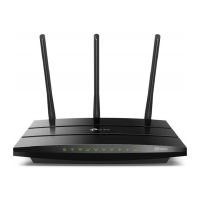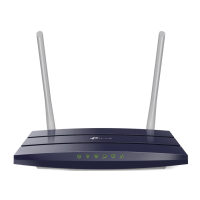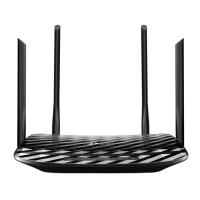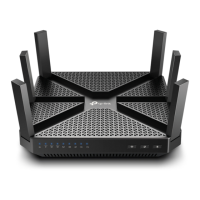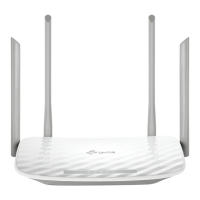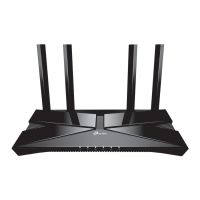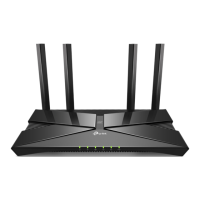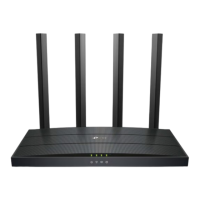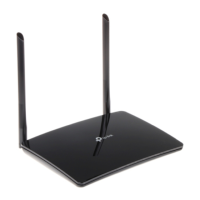
Do you have a question about the TP-Link Archer MR400 and is the answer not in the manual?
| VPN server | PPTP VPN, IPSec VPN , OpenVPN |
|---|---|
| VPN support | PPTP, L2TP, IPSec |
| Ethernet LAN | Yes |
| Frequency range | 2.4 - 5 GHz |
| Cabling technology | 10/100Base-T(X) |
| Networking standards | IEEE 802.11a, IEEE 802.11ac, IEEE 802.11b, IEEE 802.11g, IEEE 802.11n |
| Receiver sensitivity | 5GHz: 11a 54M: -74dBm 11ac HT20: -67dBm 11ac HT40: -64dBm 11ac HT80 : -60dBm 11n HT20: -71dBm 11n HT40: -70dBm 2.4G: 11g 54M: -76dBm 11n HT20: -73dBm 11n HT40: -67dBm |
| VPN tunnels quantity | 10 |
| Ethernet LAN data rates | 10, 100 Mbit/s |
| Ethernet LAN interface type | Fast Ethernet |
| USB port | No |
| Ethernet LAN (RJ-45) ports | 3 |
| Product type | Tabletop router |
| Product color | Black |
| LED indicators | LAN, Power, Status, WLAN |
| Antenna type | Internal & external |
| Transmit power | CE: \u003C20dBm(2.4GHz), \u003C23dBm(5GHz) dBmW |
| Antennas quantity | 5 |
| Transmit power range | 20 - 23 dBmW |
| Output current | 1.5 A |
| Output voltage | 12 V |
| Power source type | DC |
| Firewall security | Denial-of-Service (DoS) protection, Stateful packet inspection (SPI) firewall |
| Security algorithms | 64-bit WEP, 128-bit WEP, WPA, WPA-PSK, WPA2, WPA2-PSK |
| 4G standard | LTE |
| 2G standards | EDGE, GPRS, GSM |
| 3G standards | DC-HSPA+, HSPA, HSPA+, UMTS |
| SIM card type | MicroSIM |
| 4G bands supported | 800, 900, 1800, 2100, 2600 MHz |
| GSM bands supported | 850, 900, 1800, 1900 MHz |
| UMTS bands supported | 900, 2100 MHz |
| Supported network protocols | IPv4, IPv6 |
| Certification | CE, RoHS |
| Windows operating systems supported | Windows 2000, Windows 7, Windows 8, Windows 8.1, Windows 98SE, Windows NT, Windows Vista, Windows XP Home, Windows XP Home x64, Windows XP Professional, Windows XP Professional x64 |
| Package type | Box |
| Package depth | 223 mm |
| Package width | 307 mm |
| Package height | 70 mm |
| Package weight | 670 g |
| Cables included | LAN (RJ-45) |
| Storage temperature (T-T) | -40 - 70 °C |
| Operating temperature (T-T) | 0 - 40 °C |
| Storage relative humidity (H-H) | 5 - 90 % |
| Operating relative humidity (H-H) | 10 - 90 % |
| WAN connection type | RJ-45 |
| Wi-Fi band | Dual-band (2.4 GHz / 5 GHz) |
| Wi-Fi standards | 802.11a, Wi-Fi 5 (802.11ac), 802.11b, 802.11g, Wi-Fi 4 (802.11n) |
| Top Wi-Fi standard | Wi-Fi 5 (802.11ac) |
| WLAN data transfer rate (max) | 867 Mbit/s |
| WLAN data transfer rate (first band) | 450 Mbit/s |
| Harmonized System (HS) code | 85176990 |
| Depth | 141 mm |
|---|---|
| Width | 202 mm |
| Height | 33.6 mm |
Introduces the router's capabilities, dual-band Wi-Fi, and interchangeable LAN/WAN port for versatile connectivity.
Details the router's physical components and indicators on the top and back panels, including LED explanations.
Lists necessary items for internet sharing and router setup, including SIM card, computer, and web browser.
Provides guidance on optimal router placement for signal strength and avoiding interference from obstacles.
Explains how to connect devices via wired, wireless, or WPS methods for initial router setup.
Guides users on how to log in to the router's web interface and set up their initial password.
Guides users through an automated setup process using ISP information and time zone configuration.
Explains how to manually create an internet connection profile if ISP settings are not auto-detected.
Details how to use the router's diagnostic tool to verify the internet connection status after setup.
Explains how to set minimum/maximum bandwidth for devices to optimize network load and user experience.
Explains how to configure SPI Firewall and DoS Protection to safeguard the router from cyber attacks.
Describes how to block specific users from accessing services or the internet by creating filtering rules.
Details how to block or allow specific devices to access the network using Blacklist or Whitelist modes.
Explains how to bind IP addresses to MAC addresses to prevent ARP spoofing and other network attacks.
Guides on setting access times and website restrictions for child devices to control internet usage.
Explains how to view, compose, send, and manage SMS messages, including drafts and sent items.
Details how to set up the Message Center number for sending SMS messages from the router.
Guides on setting up separate Wi-Fi networks for guests, including SSID and password configuration.
Explains how to configure guest network settings like inter-client communication and bandwidth limits.
Describes how to configure Virtual Servers to share local services like websites or FTP servers with the internet.
Explains setting up Port Triggering to dynamically open ports for applications like online games or VoIP.
Details how to configure a DMZ host to bypass port restrictions for applications requiring unrestricted internet access.
Explains how to use UPnP to automatically manage ports for smooth online gaming and P2P applications.
Explains how to query service data from the provider using USSD requests.
Details how to manage SIM card PIN settings, including enabling PIN lock and auto-unlock.
Guides on setting data limits, alerts, and monitoring monthly data usage to prevent overuse.
Explains how to change the router's LAN IP address and subnet mask for network management.
Details how to configure the router to act as a DHCP server, assigning IP addresses to connected devices.
Describes how to reserve specific IP addresses for devices to ensure consistent network access.
Covers customizing SSID, password, and security options for 2.4GHz and 5GHz wireless networks.
Explains methods to connect devices wirelessly using WPS Push Button or PIN Code.
Details how to schedule Wi-Fi to automatically turn on/off at specific times.
Guides on checking detailed wireless network settings and client connection details.
Provides advanced wireless configuration options like Beacon Interval, RTS Threshold, and WMM.
Explains how to configure Dynamic DNS for remote access to the router using a domain name.
Details how to set up static routes for specific network paths, useful for complex network setups.
Guides on establishing IPSec VPN tunnels for secure communication between remote networks.
Explains how to configure the router's system time, including manual settings and daylight saving.
Guides on updating the router's firmware online or via a local file to improve performance and add features.
Details how to back up current configurations and restore previous settings or reset to factory defaults.
Explains how to change the router's login password for security purposes.
Guides on controlling which local devices can manage the router via the web interface.
Details how to enable remote access for managing the router from the internet.
Explains how to view, save, and analyze system logs for troubleshooting router issues.
Guides on enabling and viewing traffic statistics for LAN, WAN, and WLAN to monitor internet usage.
Explains CWMP (TR-069) settings for automatic configuration and diagnostics via an ACS server.
Details how to configure SNMP settings for network management and monitoring the router.
Explains how to reset the router to its original factory settings using the WPS/RESET button.
Provides steps for recovering or resetting the web management and wireless passwords.
Offers troubleshooting steps for users unable to access the router's web interface.
Troubleshoots problems related to no internet access, including SIM card, ISP parameters, and LAN checks.
Provides guidance on improving slow internet speeds, including signal reception and Wi-Fi channel optimization.
Explains how to configure the router to operate in Wireless Router mode, sharing internet from another modem.
Addresses issues with finding or connecting to wireless networks, including authentication and signal strength.
